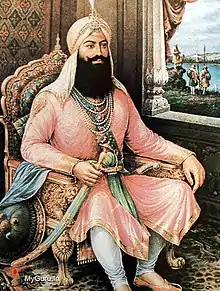Jassa Singh Ramgarhia
Jassa Singh Ramgarhia (1723–1803) was a prominent Sikh leader during the period of the Sikh Confederacy. He was the Commander of the Ramgarhia Misl (or Confederacy). Detailed accounts of his life vary.
Jassa Singh Ramgarhia | |
|---|---|
 Jassa Singh Ramgharia seated upon his throne. | |
| Born | 1723 |
| Died | 1803 (aged 79–80) |
| Known for | Sardar of the Ramgarhia Misl |
| Successor | Jodh Singh Ramgarhia who ceded his territories to Maharaja Ranjit Singh |

Early life
Jassa Singh Ramgarhia was born into a Sikh family[1] with surname Bhambra in 1723. According to W. H. McLeod,[2] his birthplace was the village of Ichogil, near Lahore, whilst H. S. Singha[3] refers only to Lahore and Purnima Dhavan[4] mentions origins in either Guga or Sur Singh, both near Amritsar. There is agreement among the sources that he was of Tarkhan [5] origin and was originally named Jassa Singh Thokar. (Jassa Singh the Carpenter).[2][3][4] He had four brothers - Jai Singh, Khushal Singh, Mali Singh Ramgarhia and Tara Singh - and became head of the family when his father, Giani Bhagwan Singh, died.[6]
Career
Jassa Singh rose to command the Sikh misl that became later known as Ramgarhia and built a fort called Ram Rauni and Ramgarhia Bunga (watchtower) at Amritsar. He joined forces with Adina Beg, who appointed him a risaldar (commander), but switched sides when asked by him to attack the fort during the Siege of Ram Rauni. He defended it against Adina Beg's siege and, in 1752, rebuilt the damaged fort. The edifice was renamed Ramgarh, from which he took his new name.[2][7][lower-alpha 1]
Jassa Singh's policies were in contrast to those of other misl leaders. The large size of Jassa Singh’s territory aroused the jealousy of the other Sikh Misls. They did not want him to become too powerful and the ruler of a big region. At the height of his power, Jassd Singh's territory in the Bari Doab included Batala, Kaldnaur, Dinanagar, Sri Hargobindpur, Shahpur Kandi, Gurdaspur, Qadian, Ghuman, Matteval, and in the Jalandhar Doab, Urmur Tanda, Sarih, Miani, Garhdivala and Zahura. In the hills Kangra, Nurpur, Mandi and Chamba paid him a tribute of two lakh of rupees. In 1776, the Bhangis betrayed Ramgarhia and joined the Khaniyas to defeat Jassa Singh. Thereafter, he turned his attention to the area around the Jamna river and Delhi, briefly holding control of the latter.[2]
Purnima Dhavan says that "Jassa Singh Ramgarhia appeared to have a shrewd grasp of realpolitik, relying equally on diplomatic persuasion and martial prowess to accomplish his goals. ... [His] supporters appear to have valued his political acumen, plain-spoken behaviour, and simple if rough ways".[7]
He died in 1803 and was succeeded by his son, Jodh Singh Ramgarhia, who ceded his territories to Ranjit Singh.
The critical decision of Jassa Singh to join the Khalsa and save the Ram Rauni fort changed the course of not only his own life but that of Sikh history as well. He was honoured as Ramgarhia. His name will always remain alive as the founder of the Great Ramgarhia Misl, who played a major role in the battles of the Khalsa Panth.[2]
Delhi Fateh

Sardar Jassa Singh Ramgarhia captured the Red Fort after defeating Mughals in the Battle of Delhi (1783) in conjunction with Sardar Baghel Singh. He detached the throne of Mughal emperor Aurangzeb (on which he ordered the death of 9th guru Guru Teg Bahadur ji) and brought it on elephants and kept it at Golden Temple, Amritsar. Even today it is present at the Golden Temple known as Ramgarhia Bunga.[8]
Legacy
An equestrian statue[9] of Sardar Jassa Singh Ramgharia has been installed in Amritsar, Punjab.
References
Notes
- The suffix -garh is translated as fort.
Citations
- History of the Sikhs Vol. 4: The Sikh Commonwealth or Rise and Fall of the Misis Pg 276 hari ram gupta ISBN 978-8121501651
- McLeod, W. H. (2005) [1995]. Historical Dictionary of Sikhism (2nd ed.). Scarecrow Press. p. 102. ISBN 0-8108-5088-5.
- Singha, H. S. (2005) [2000]. The Encyclopaedia of Sikhism (2nd ed.). Hemkunt. p. 111. ISBN 81-7010-301-0.
- Dhavan, Purnima (2011). When Sparrows Became Hawks: The Making of the Sikh Warrior Tradition, 1699-1799. USA: OUP USA. p. 60. ISBN 978-0199756551.
- Sikhs and Sikhism, WH Mcleod, pg102
- Warrior-diplomat: Jassa Singh Ramgarhia - Harbans Singh Virdi
- Dhavan, Purnima (2011). When Sparrows Became Hawks: The Making of the Sikh Warrior Tradition, 1699-1799. USA: OUP USA. p. 81. ISBN 978-0199756551.
- Singh, Pashaura; Barrier, Norman Gerald (1999). Sikh Identity: Continuity and Change. Manohar. p. 264. ISBN 978-81-7304-236-2.
- "Equestrian statue of Jassa Singh Ramgarhia in Amritsar, Punjab India". 6 April 2016.
Further reading
- "The heritage of the Sikhs" by Harbans Singh
- Singh, Khushwant (1991). A History of the Sikhs, Volume 1: 1469-1839. Oxford University Press. pp. 134, 140, 160, 178–181.
- The Sikh Commonwealth or Rise and Fall of Sikh Misls. (Date:2001, revised edition. ISBN 81-215-0165-2)